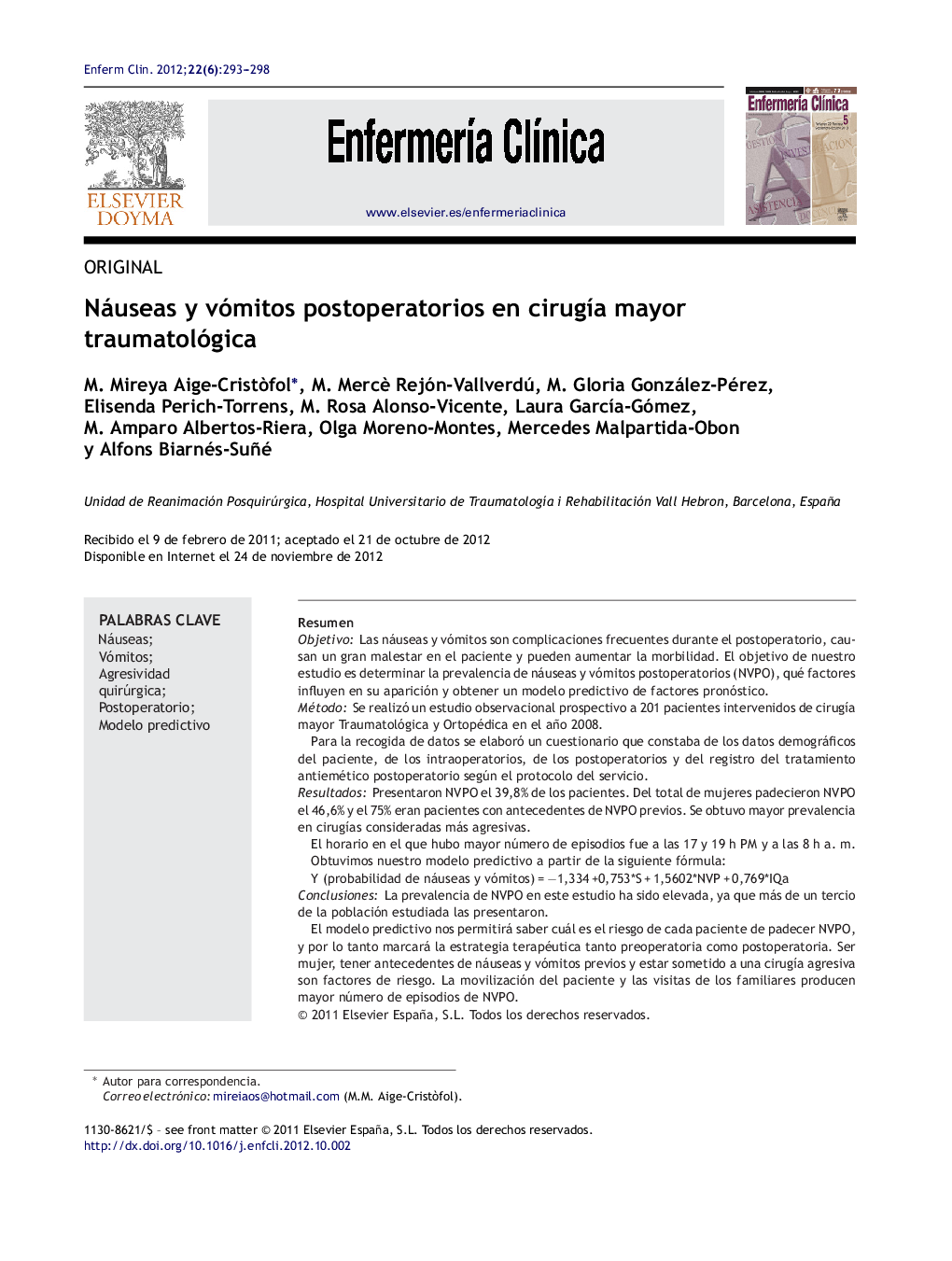| کد مقاله | کد نشریه | سال انتشار | مقاله انگلیسی | نسخه تمام متن |
|---|---|---|---|---|
| 2648055 | 1139095 | 2012 | 6 صفحه PDF | دانلود رایگان |

ResumenObjetivoLas náuseas y vómitos son complicaciones frecuentes durante el postoperatorio, causan un gran malestar en el paciente y pueden aumentar la morbilidad. El objetivo de nuestro estudio es determinar la prevalencia de náuseas y vómitos postoperatorios (NVPO), qué factores influyen en su aparición y obtener un modelo predictivo de factores pronóstico.MétodoSe realizó un estudio observacional prospectivo a 201 pacientes intervenidos de cirugía mayor Traumatológica y Ortopédica en el año 2008.Para la recogida de datos se elaboró un cuestionario que constaba de los datos demográficos del paciente, de los intraoperatorios, de los postoperatorios y del registro del tratamiento antiemético postoperatorio según el protocolo del servicio.ResultadosPresentaron NVPO el 39,8% de los pacientes. Del total de mujeres padecieron NVPO el 46,6% y el 75% eran pacientes con antecedentes de NVPO previos. Se obtuvo mayor prevalencia en cirugías consideradas más agresivas.El horario en el que hubo mayor número de episodios fue a las 17 y 19 h PM y a las 8 h a. m.Obtuvimos nuestro modelo predictivo a partir de la siguiente fórmula:Y (probabilidad de náuseas y vómitos) = −1,334 +0,753*S + 1,5602*NVP + 0,769*IQaConclusionesLa prevalencia de NVPO en este estudio ha sido elevada, ya que más de un tercio de la población estudiada las presentaron.El modelo predictivo nos permitirá saber cuál es el riesgo de cada paciente de padecer NVPO, y por lo tanto marcará la estrategia terapéutica tanto preoperatoria como postoperatoria. Ser mujer, tener antecedentes de náuseas y vómitos previos y estar sometido a una cirugía agresiva son factores de riesgo. La movilización del paciente y las visitas de los familiares producen mayor número de episodios de NVPO.
ObjectivePostoperative nausea and vomiting (PONV) are common complications during the postoperative period, causing important discomfort to the patient and also can increase morbidity. The objective of our article is to predict the prevalence of postoperative nausea and vomiting, the factors that have an influence on its appearance, and to obtain a predictive model based on prognostic factors.MethodA prospective observational study was conducted on 201 patients who underwent major Orthopaedic and Trauma surgery during the year 2008.A questionnaire was designed to collect the required data as established previously by a standardized protocol, in which was requested, patient demographics, intraoperative and postoperative data, as well as details on any antiemetic treatment that was needed in the recovery ward.ResultsA total of 39.8% patients suffered PONV. Of the females, 46.6% suffered PONV, and 75% had previous history of PONV. A higher prevalence was observed in patients who were subjected to more aggressive surgery.There was a concentration of cases between 5 pm and 7 pm, and also at 8 am.The predictive model was obtained from this formula:Y = −1,334 + 0,753*S + 1,5602*NVP + 0,769*IQaConclusionsThe prevalence of PONV in this study has been high, as more a third of the studied population suffered from it.The predictive model should help determine the specific risk of each patient of suffering from PONV, thus being able to define a therapeutic strategy during the preoperative period as well as during the postoperative period. Being female, a previous history of PONV, and undergoing an aggressive surgical procedure are risk factors. Patient mobilization and family visits increase the number of PONV episodes.
Journal: Enfermería Clínica - Volume 22, Issue 6, November–December 2012, Pages 293–298